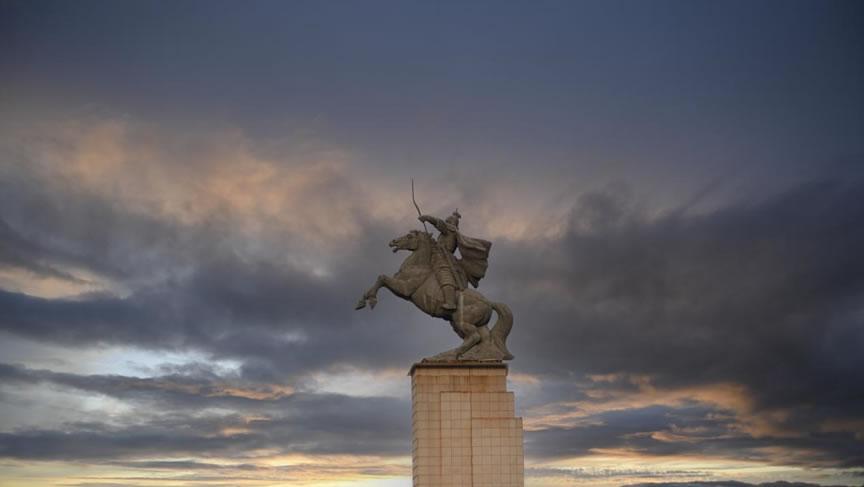Hu-style wear and cavalry building

In 403 BC, the State of Jin (1033-376 BC) was divided by the states of Zhao, Wei, and Han, which were recognized by the Zhou Emperor as vassal states. It marked the beginning of the Warring States Period (475-221 BC) in Chinese history. As a vassal state in the Central Plains, the State of Zhao was threatened frequently by nearby states and some Hu tribes.
How did the State of Zhao adopt Hu-style wear and build cavalry in the army?
The state of Zhao covered a territory of the northern and central parts of present-day Shanxi Province, western and southern parts of present-day Hebei Province, and a region to the south of the Yin Mountains in Inner Mongolia. Before King Wuling of Zhao (325-299 BC) started his military reform, the nearby Zhongshan kingdom, Linhu, Loufan, and Donghu tribes in the north, all nomadic tribes, constantly invaded the border areas of the state of Zhao.
During the early years of the Warring States period, Yue Yang, a general of the Wei (472-396 BC) was sent to annihilate the Zhongshan kingdom. Decades later, the Zhongshan kingdom reappeared and frequently harnessed Zhao's borders. Having been defeated several times by the Zhongshan troop, King Wuling of Zhao felt an urgent need to turn things around.
At that time, the costumes of the Central Plains states were heavily influenced by traditional etiquette, and people wore long robes with loose sleeves. Costumes also varied between different social classes within an established hierarchical system, yet all shared a common feature that they were not suitable for cavalry combat. The uniforms worn by the Zhao soldiers were wide and long, making it difficult for them to chase enemies or shoot arrows on horseback. However, the clothes worn by the nomadic Hu were quite different. Hu soldiers wore short jackets with tight sleeves, long trousers, leather boots, and leather belts with buckles, enabling them to fight comfortably on horseback.
To help the military better adapt to fighting battles, King Wuling of Zhao started his reform. He ordered all his soldiers to adopt the Hu style of wear—trousers, belt, and boots—to improve the efficiency of training and fighting. He also created a cavalry division in three ways. First, he recruited cavalrymen from among the commoners in the State of Zhao who knew how to ride and shoot. Second, he built military bases for cavalry training in places with lush greenery and clear water. Last, he enlisted Hu prisoners and local Hu civilians to join his cavalry.
Wearing Hu-style clothes and setting up cavalry units proved to be a successful reform. Then the Zhao State defeated the Linhu and Loufan tribes, conquered new territories extending far, and even annihilated the Zhongshan kingdom. Hu-style wear and cavalry building had a tremendous impact on the development of the Central Plains. After that, other states followed suit in establishing their own cavalries.
Why do we say that Hu-style wear and cavalry building was also a successful effort for ethnic integration?
Exchanges between the Zhao and other nomadic tribes like Linhu, Loufan, Donghu, Yiqu, and Zhongshan promoted interracial marriages. Many Hu people and their descendants settled down in the state of Zhao, which facilitated the transmission of their cultures within the state of Zhao. These interactions helped spread the culture of the Central Plains to the nomadic tribes in the north and west; in turn, the state of Zhao learned animal husbandry and bought cattle, sheep, and furs from the tribes. Such an open and inclusive culture made it possible for King Wuling of Zhao to carry out his military reform.
In fact, it can be seen from the history of the State of Zhao that it was a multi-ethnic state. King Wuling's military reform was an example of how to study the best parts of the culture of other tribes and incorporate them into his own. His reform accelerated cultural exchange and led to a cultural blending of different ethnic groups. It should be noted that ethnic integration was not only taking place in the State of Zhao; similar cases could be found in other states and regions as well.
Nevertheless, the number of states was on a decline, from over 100 states during the Spring and Autumn Period (770-476 BC) to some 20 states during the Warring States Period. The seven warring states, namely the Qin, Han, Wei, Zhao, Qi, Chu, and Yan were all multi-ethnic states, with the Qi being inhabited by the Yi tribes in the east, the Qin by Rong tribes in the west, and the Yan by Di tribes in the north. The Chu, which had the largest territory, was inhabited by several ethnic groups including the Yi, Yue, Pu, and Man, in addition to the indigenous people. The descendants of Di tribes also lived in the states like Zhao, Wei, and Han. Close interactions between various ethnic groups and the Han people formed ethnic integration and promoted the overall development of Chinese civilization.
King Shun (about 2128-2025 BC) was actually from the Eastern Yi group; King Wen (1152 BC-1056 BC) of the Zhou was from the Western Yi group. Both are revered as sages by the Chinese. This demonstrates that since ancient times, a close relationship had already existed between the ethnic groups in the Central Plains and those in the surrounding areas. According to Professor Cho-Yun Hsu, the word Yi originally meant "the other." In this sense, the military reform by King Wuling of Zhao was fundamentally a reflection of ethnic integration during the Spring and Autumn Period and the Warring States Period, signifying the openness and inclusiveness of the Chinese civilization.
The author is Tian Hailin at the Ethnic Cultural Palace.
Liu Xian /Editor Chen Haixia, Yang Lin /Translator
Yang Xinhua /Chief Editor Ren Qiang /Coordinator
Liu Li /Reviewer
Zhang Weiwei /Copyeditor Tan Yujie /Image Editor
The views don't necessarily reflect those of DeepChina.
